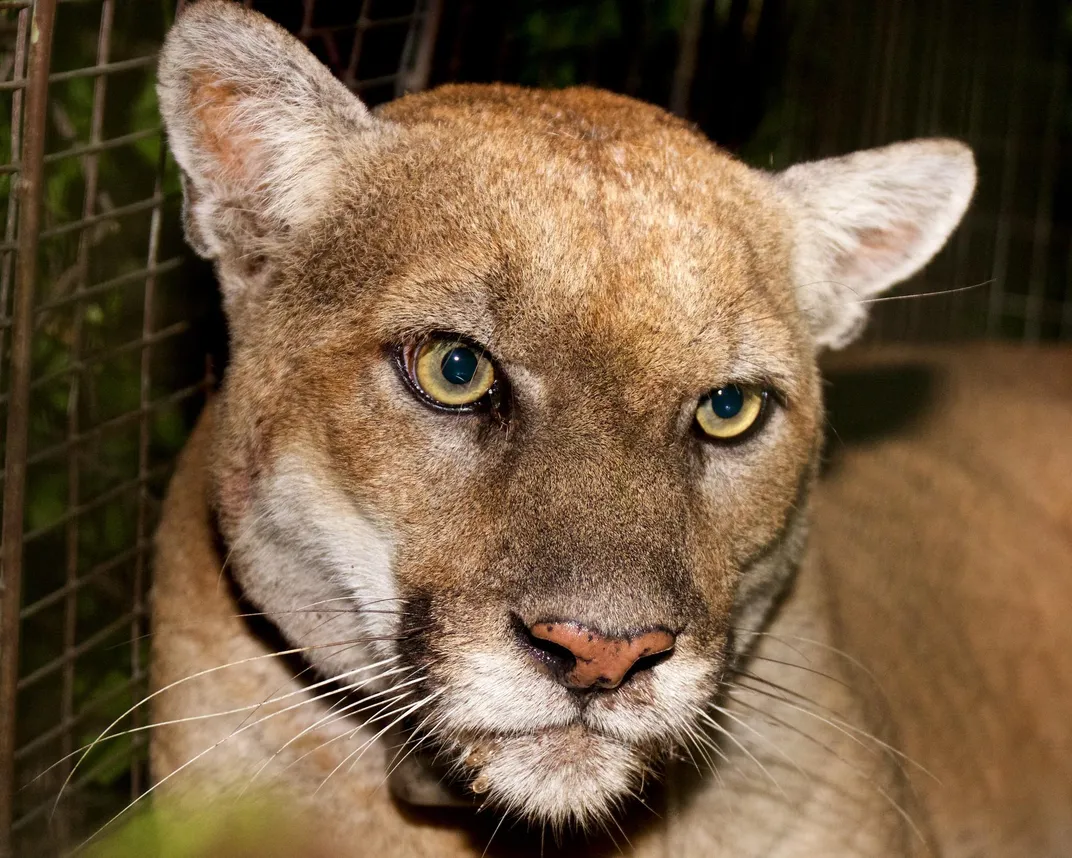California Will Build the Largest Wildlife Crossing in the World
The overpass will provide safe passage for mountain lions, coyotes, deer, lizards, snakes and other wild animals crossing the 101 Freeway
/https://tf-cmsv2-smithsonianmag-media.s3.amazonaws.com/filer/30/ef/30ef6411-9356-4cb1-b6a0-1e7c1ab9ba3d/mtn_momp19_16579239960_f5e6222ac7_k.jpg)
A planned animal overpass set to stretch over Los Angeles’ 101 Freeway has entered its final design phase, Christopher Weber reports for the Associated Press. Dubbed the Liberty Canyon Wildlife Crossing, the 200-foot-long bridge—expected to provide safe passage for lions, coyotes, deer, lizards, snakes and other wild creatures—is on track for groundbreaking within the next two years and slated to open by 2023.
According to Weber, the crossing will enable Southern California’s native wildlife to more freely roam the region’s urban sprawl. Currently, animals hoping to cross the highway are at high risk of becoming roadkill; as a result, most are essentially trapped in the Santa Monica Mountains, unable to venture out in search of food and potential mates.
This limited geographic range poses a particular threat to mountain lions. Per a study published in the journal Ecological Applications this March, two isolated populations in the Santa Ana and Santa Monica Mountains face extinction within the next 50 years due to low genetic diversity and mortality linked with human activity and environmental changes. By connecting solitary big cats with other members of the species, the Liberty Canyon overpass could curb mountain lion inbreeding and reintroduce genetic diversity to local populations.
“When the freeway went in, it cut off an ecosystem,” Beth Pratt, director of the National Wildlife Federation’s California branch, tells the AP’s Weber. “We’re just now seeing impacts of that.”
Pratt adds, “They can’t get out of here to get dates, and cats can’t get in to get dates. ... For those of us in L.A., having a romance prospect quashed by traffic is something we can all relate to.”
Weber explains that 80 percent of the funds needed to construct the $87 million bridge will come from private sources, while the remaining 20 percent will be drawn from public funds allocated toward conservation campaigns. According to authorities, the Liberty Canyon Wildlife Crossing will be not only the first of its kind built near a major metropolis, but the largest in the world.

As a #SaveLACougars campaign report notes, the proposed design features a 165-foot-wide by 200-foot-long bridge constructed at the freeway’s 33.0 mile marker. Stretching across 10 lanes of highway traffic, the overpass will also include an extension above nearby Agoura Road. Per Avishay Artsy of a KCRW local radio show, the crossing will strive to resemble an extension of the surrounding mountainside, boasting extensive plant cover, as well as sound- and light-blocking barriers.
Speaking with National Geographic’s Starre Vartan in April, Rob Ament, road ecology program manager at Montana State University’s Western Transportation Institute, said that under- and overpasses can reduce mortality rates and monetary costs associated with wildlife-vehicle collisions by 85 to 95 percent. First introduced in France during the 1950s, such crossings are popular in Europe and becoming increasingly common across the world. Last December, cameras spotted the first wild animal to use an overpass built above Washington State’s Interstate 90, and in October, California opened its first wildlife crossing at a spot near Temecula, around 60 miles north of San Diego.
Southern California’s most famous mountain lion, a male known as P-22, is the poster child for the #SaveLACougars campaign—or as Pratt calls him “the Brad Pitt of the cougar world.” Because he lives in a park miles from the crossing, he likely won’t end up using it, but many of his relatives are poised to benefit from the bridge, reports AP’s Weber. Lions rarely cross local freeways successfully, but the Orange County Register’s Martin Wisckol writes that a 4-year-old male dubbed P-61 made his way across the 405 freeway unimpeded just last month. P-22 made a similar journey years ago, crossing the 405 and 101 highways to reach his current home in Griffith Park.
According to the cougar campaign’s report, P-22’s living situation is “less than ideal,” as he is now virtually trapped in the confines of the Los Angeles park and unlikely to be joined by a potential mate anytime soon. As the report states, “Building a wildlife crossing will help other mountain lions avoid P-22’s fate.”
Clark Stevens, an architect with the Santa Monica Mountain’s Resource Conservation District, tells Weber that “ideally, the animals wil never know they’re on a bridge.”
He concludes, “It’s landscape flowing over a freeway. It’s putting back a piece of the ecosystem that was lost.”
/https://tf-cmsv2-smithsonianmag-media.s3.amazonaws.com/accounts/headshot/mellon.png)
/https://tf-cmsv2-smithsonianmag-media.s3.amazonaws.com/accounts/headshot/mellon.png)